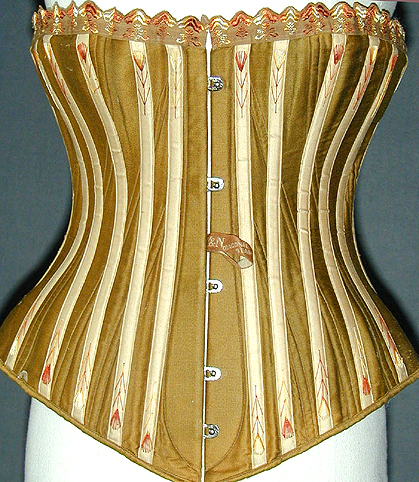We agree it’s WEIRD, but is it WEIRD enough? Greg Downey at Neuroanthropology gives his take on Henrich et al.’s paper The weirdest people in the world? which looks at acronym WEIRD (Western, Educated, Industrialized, Rich, and Democratic) and how we may be extrapolating too much from this particularly narrow data set. Yet, despite this, we continue to use WEIRD individuals in psychological experiments, even though it may not be representative of, say, the large body of Africans. I mean, come on, you wouldn’t take genetic data from Western Europe and then make sweeping generalisations about populations in Western Africa…
The Human Penis Bone. From WEIRD to just weird. Scicurious reviews a very old journal article from 1913, which tells of a guy who actually grew a penis bone. Now, many mammals do have penis bones, but human males generally lack this ossified aid. However, if you’re curious about how to get one, then all you have to do is simply wear a particular type of corset (see below) and, here’s a downside for those of you planning on ditching the Viagra, get syphilis. As Scicurious explains:
The syphilis, combined with the constant irritation of the corset, had apparently caused a build up of desposits, which eventually ossified and turned in to bone. REAL BONE, with marrow and holes in it and everything! […] So the moral of this story is: if you’re a guy, and you’re vain about your appearance, get a flat front corset. You don’t want to be sitting down in something pointy.

Wild cat found mimicking monkey calls. Some clever vocal mimicry from a margay. ScienceDaily reports:
Researchers first recorded the incident in 2005 when a group of eight pied tamarins were feeding in a ficus tree. They then observed a margay emitting calls similar to those made by tamarin babies. This attracted the attention of a tamarin “sentinel,” which climbed down from the tree to investigate the sounds coming from a tangle of vines called lianas. While the sentinel monkey started vocalizing to warn the rest of the group of the strange calls, the monkeys were clearly confounded by these familiar vocalizations, choosing to investigate rather than flee. Four other tamarins climbed down to assess the nature of the calls. At that moment, a margay emerged from the foliage walking down the trunk of a tree in a squirrel-like fashion, jumping down and then moving towards the monkeys. Realizing the ruse, the sentinel screamed an alarm and sent the other tamarins fleeing.
Nongenetic selection and evolution: flies use bacteria to adapt to parasitic worms. Jerry Coyne has a fascinating post about nongenetic evolution occurring in a mushroom-eating fruit fly Drosophila neotestacea. But how is it nongenetic? Well, as Jerry explains:
A new paper by John Jaenike and his colleagues in Science, however, shows a form of biological evolution by natural selection that isn’t based on changes in genes. It’s based on changes in the presence of symbiotic bacteria that protect a species from parasites […] Some flies also carry another organism: the bacterial symbiont Spiroplasma, which is found in many insects. In D. neotestacea, however, the presence of Spiroplasma protects the fly from the sterilizing effects of nematodes. While flies with worms and no Spiroplasma are virtually sterile, the presence of the bacteria confers almost normal fertility on worm-ridden flies. It’s not yet clear how this works, but worms in flies with Spiroplasma are much smaller than those without the bacteria. Presumably the bacteria does something to the worms (or to the flies) that makes the worms grow much more slowly.
![]()
![]() I always remember 2008 as the year when the entire UK media descended upon the former mining town of Bridgend. The reason: over the course of two years, 24 young people, most of whom were between the ages of 13 and 17, decided to commit suicide. At the time I was working in Bridgend, so I’m able to appreciate the claims of local MP, Madeleine Moon, that media influence had become part of problem. After all, most editors will tell you: the aim is to sell newspapers. And when this rule is rigorously applied, it should not come as a surprise at the depths some journalists will sink to recycle a news story. Even at a local-level, where you’d think some civic responsibility might exist, journalists clambered over themselves to find a new angle, generating ridiculous claims such as: electromagnetic waves from mobile phones caused the suicides.
I always remember 2008 as the year when the entire UK media descended upon the former mining town of Bridgend. The reason: over the course of two years, 24 young people, most of whom were between the ages of 13 and 17, decided to commit suicide. At the time I was working in Bridgend, so I’m able to appreciate the claims of local MP, Madeleine Moon, that media influence had become part of problem. After all, most editors will tell you: the aim is to sell newspapers. And when this rule is rigorously applied, it should not come as a surprise at the depths some journalists will sink to recycle a news story. Even at a local-level, where you’d think some civic responsibility might exist, journalists clambered over themselves to find a new angle, generating ridiculous claims such as: electromagnetic waves from mobile phones caused the suicides.
